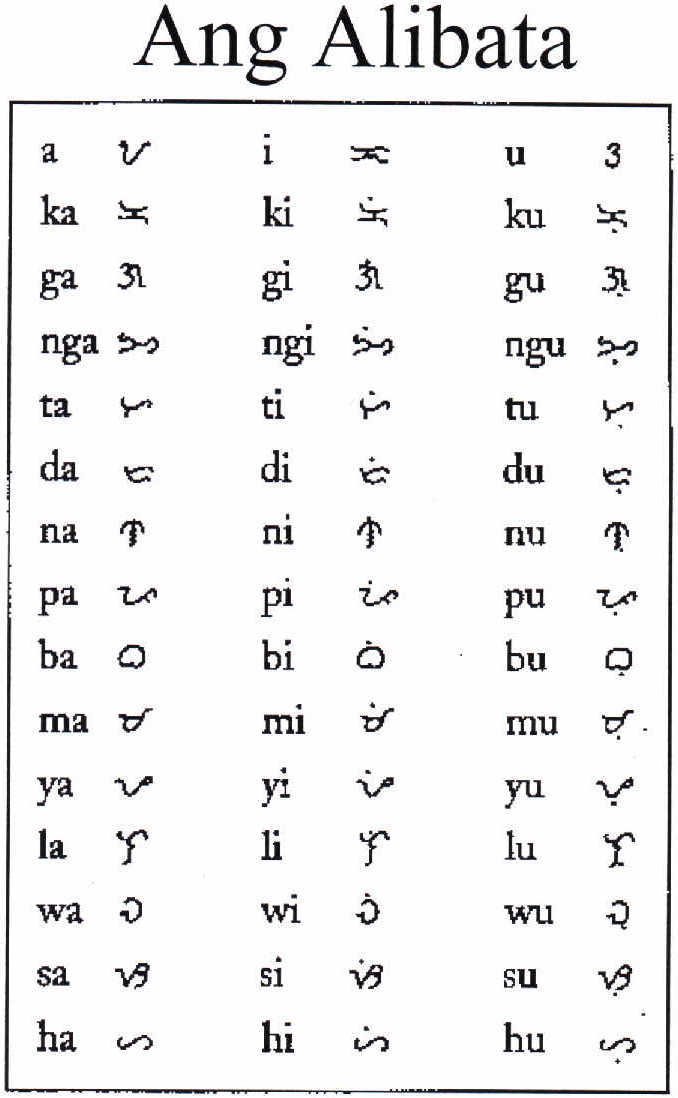Baybaying Alibata
December 31, 2008Alibata - Baybayin
When the Spaniards arrived to the Philippines, they discovered the people in Manila, then a port town and other places making use of bamboo and specially prepared palm leaves to write on using styli and knives. The locals had been using an ancient Tagalog script which had 17 basic symbols of which three were vowels, namely a, i and u. The other symbols were consonants which had an inherent sound, i.e. ka, ga, nga, ta, da, na, pa, ba, ma, ya, la, wa, sa, and ha.
The Tagalog script that eventually became known as Baybayin and later Alibata was syllabary, meaning that each of the symbols represented a complete syllable. This in contrast to the standard Latin alphabet as it is today, the symbols represent a phoneme or the smallest unit of speech. This particular distinction is what made it difficult for many people especially from the west, who have been familiar with the alphabetic system, understand the correct usage of the Tagalog script.
Understanding the Script
The Kudlit is a diacritical mark which modified the sound of the symbol. The kudlit could either be a short line, a dot or an arrowhead. When this is placed above the symbol, it inherently changed the the sound of the symbol for a to i, when it is placed below, then the sound became a u. So for instance a ba with a kudlit placed above would become bi, and it the kudlit was placed below, then the symbol became a bu. This was simple and elegant system was called baybayin and in 1914 this became alibata which it is now more commonly known as.
The script being a very basic one only represented two levels of syllables, and these are the V and CV where in the C is a consonant and the V is a vowel. However the language in general had V, CV, VC and CVC sysllables and this meant that syllables such as ku and bi would not be wriiten down with the script as accurately as it should be. There are syllables like, kam, ting (ng considered as a single consonant) and pit could not even be written at all using the system owing to the fact that Tagalog did not have in its system consonant clusters such as CCVC which would have solved the problem.
The Evolution of the Missing Final Consonant.
Writing down syllables of the CVC type of syllables, the ancient Filipino natives just dropped the final consonant for simplicity. So ak would just be written as a, pit as pi, ting as ti, kam as ka, and so on. The missing final consonant eventually made its way back and was added back as the text was later read using a technique which to this day is not understood and will perhaps forever remain a mystery. For those who have had initial training in literacy with alphabets would perhaps think only of context as the means to give clues as to the reason behind the missing consonant, however there may have been other elements or circumstances that we may not be aware of that enable the ancient peoples to determine what the missing consonant was in the Alibata.
The incompleteness of the Alibata script are often attributed to such theories that these scripts were relatively new developments in the Philippine cultures, and as such they did not have time to evolve further in order to deal with the inherent deficiencies. With the coming of the Arab culture and Islam through trade somewhere around the 9th Century may have further hampered this evolution and with colonization from Europe starting in the 16th century totally hindered this evolution. Furthermore, since these scripts like the Alibata, in the strictest sense, were not totally an indigenous development, in the sense that they were not particularly suited to represent Philippine languages.
Such is the history of the Filipino's ancient writing of Alibata.
Posted by Batang Alibata. Posted In : Alibata

